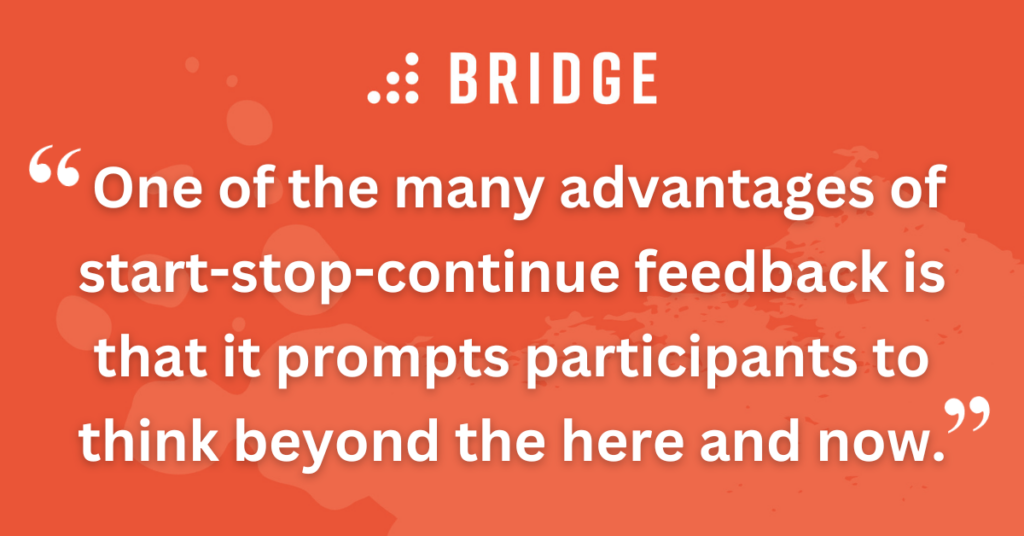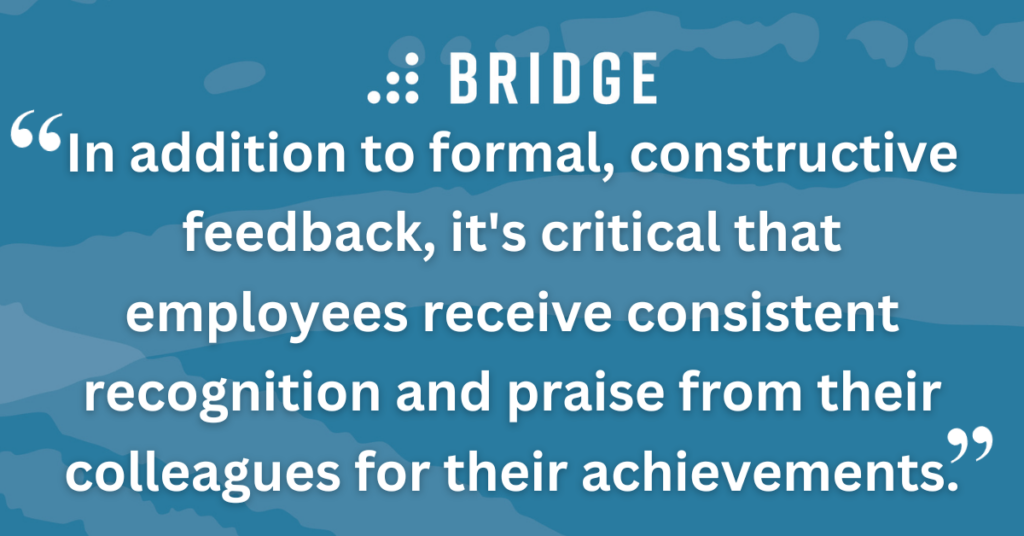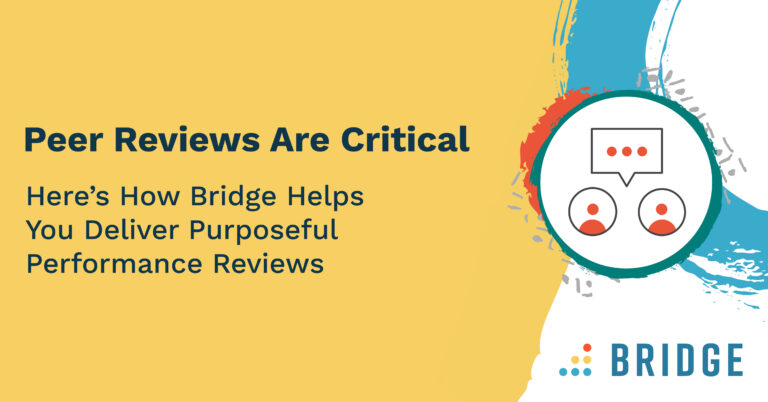Feedback is the lifeblood of performance management. Not only is it essential for employees to receive guidance as they grow in their roles, but good feedback also brings its own rewards. Employees who receive meaningful feedback are more likely to be engaged.
According to Bridge’s Future of Performance Management report, performance management leaders are nearly twice as likely to say that they implement a culture of continuous feedback and adopt structured and formalized performance conversations. Moreover, these leaders are more likely to agree that their processes allow them to evaluate employee performance accurately.
Embedding peer reviews into your performance management practices is a valuable way to drive personal and professional growth with actionable and relevant insights. That’s why Bridge’s performance management platform enables you to collect, organize, and structure formal and informal forms of feedback.
By bringing together employee recognition, skills feedback, and peer reviews into performance conversations, you have all the elements needed to evaluate, measure, and drive growth.
Read on to discover the role peer-to-peer feedback plays in performance conversations and how Bridge’s platform gives you the tools to implement strategic and purposeful performance reviews.
What Forms of Peer Feedback Can You Do in Bridge?
With a holistic approach to employee performance tied to your strategic performance objectives, you get a complete evaluation of your people's strengths, successes, and areas for growth.
Implementing a continuous approach to feedback is an effective way to improve transparency while tracking and measuring employee achievements and progress. Within Bridge's performance management platform, you can collect the following forms of peer feedback:
- Peer reviews
- Employee recognition
- Skills feedback
- Start/stop/continue feedback
Combining these structured peer reviews with year-round recognition and ongoing skills feedback makes performance conversations actionable, forward-focused, and relevant.
Let’s look at each form of peer feedback in more detail.

The Critical Role Peer Reviews Play in Performance Conversations
Although formal performance conversations might only occur once or twice annually, they have a year-long impact. They offer an opportunity for employees to review goals, reflect on their growth, and assess future development opportunities with their managers.
These discussions are more effective when managers and employees prioritize regular 1:1s. But since managers can't be everywhere and see everything their people do, using peer reviews within Bridge provides a well-rounded view of employee performance from those who work closely with them. This structure is particularly useful for project-based organizations and team structures where managers don't oversee their team's day-to-day work.
Adopting these structured peer reviews as part of performance conversations helps fill any gaps and encourages managers and employees to see alternative perspectives about where people shine and the areas in which they could use additional support. These insights also allow for more targeted, in-depth evaluation and goal alignment.
In addition, peer-to-peer reviews promote collaboration and create accountability among your people. Instead of relying on the traditional top-down approach, you give employees a role in shaping each others' growth and recognizing their contributions.
How to Run Peer Reviews in Bridge
Peer reviews are an optional addition to formal performance conversations that can be used in combination with employee and manager evaluations. As with other aspects of the performance conversation, your admins can customize requirements within Bridge to suit your organization's needs and best reflect your people's contributions.
This includes setting the number of required reviewers to ensure your people receive a balanced view of their performance. Your admins can specify start and end dates for review cycles and choose whether to anonymize peer feedback. You also have the power to create specific questions and rating scales for peer reviewers that will give you the most valuable and actionable data.
Since the review process is collaborative between people and managers, employees can choose which peers evaluate their performance. However, managers get the final sign-off in approving the peer list and can add additional reviewers of their choice.
Once completed, peer reviews are available within both manager and shared performance conversation agendas in Bridge. During performance conversations, these responses can be used as talking points to provoke deeper discussion and open a two-way dialogue. This enables employees to become more active participants, allowing them to reflect on past performance and strategically plan ahead.
However, you don't have to wait until annual performance conversations to give employees the chance to share relevant and actionable feedback with others.
LEARN MORE | ‘Why Performance Reviews Shouldn’t Be a Once-a-Year Deal’
How to Conduct Start-Stop-Continue Feedback and Skills Feedback
In Bridge, there are two forms of regular feedback that employees and their managers can request at any point during the year.
Skills feedback shows employees how they're performing in the essential capabilities needed for their roles. Your people can request this form of feedback from peers, managers, and direct reports, providing them with a visualization of the compiled results.
Incorporating this form of peer feedback is valuable for your managers as it supplies them with real-time insights to drive employee development and track goals. When this is a habit commonly practiced among your people, you'll soon build a picture of organization-wide goal alignment and skills mastery at a given moment.
Similarly, start-stop-continue feedback (sometimes known as stop/keep-doing/start, or SKS) is a method for delivering targeted feedback. It's a clear and actionable approach that prompts peers to raise, discuss, and address the answers to three key questions:
- Start: What helpful actions can an employee take in order to improve their job performance?
- Stop: What actions can an employee stop doing in order to improve their job performance?
- Continue: What actions should an employee continue to take?
These are simple questions, but they immediately add structure and ensure feedback is constructive.. Not sure what these questions might look like in practice? Let’s take a look at an example or two.
ADDITIONAL INSIGHTS | ‘Continuous Feedback: The Key to the Best Performance Reviews’

Examples of Start-Stop-Continue Feedback for Employees
As with any form of feedback, the information your employees receive will depend on a range of factors, including their job roles, whether they're fully established in the organization or still onboarding, and who's giving the feedback.
To illustrate what start-stop-continue feedback looks like in action, let's take a look at the kind of feedback a junior sales executive at a financial services firm might receive from their manager:
As these examples suggest, one of the many advantages of start-stop-continue feedback is that it prompts participants to think beyond the here and now. If you’re required to reflect on what an employee isn’t doing, you might just find yourself encouraging them to take steps that go beyond their day-to-day activities—and nudging them toward advancement and upskilling.
- Start: Taking leadership training in anticipation of any future leadership opportunities.
- Stop: Working beyond your assigned hours. Remember to take a break and establish a better work-life balance.
- Continue: Frequently communicating with clients, who really value the level of attention you give them.
Examples of Start-Stop-Continue Feedback for Managers
When you use Bridge's feedback features, you're not limited to a top-down approach in which employees simply receive leadership-driven feedback. Everyone has room for growth, change, and improvement—which is why any employee can solicit feedback from anyone, whether they're peers, reports, CEOs, or people from other departments.
If you make a feedback request directed toward fewer than five people, Bridge will prompt you to add more—ensuring that each employee receives diverse perspectives on their progress.
As such, Bridge users often solicit feedback from their peers. Managers can also gain valuable insights from feedback from their direct reports. For example:
- Start: Providing a little more clarity when it comes to task-related deadlines, ensuring that your reports can prioritize their workloads.
- Stop: Relying on your reports to help you understand our workplace’s technologies and processes.
- Continue: Making time for your reports whenever anyone has any issues to discuss.
It doesn’t hurt to end this kind of feedback on a more positive note, represented by the “continue” stage. Positivity is an essential element of good feedback cultures, so you need to pair your formalized start-stop-continue feedback with the less structured and more ad hoc encouragement that comes with employee recognition.

Recognition Feedback Explained
In addition to formal, constructive feedback, it's critical that employees receive consistent recognition and praise from their colleagues for their achievements. According to the CIPD, this approach can lead to tangible performance improvements even among low-performing employees. So, how does that work? It's all about having a strengths-first outlook.
The report points to the value of amplifying and replicating existing strengths via methods like the "feed-forward interview". This is a process in which an employee discusses a recent positive event and identifies how the event's performance-friendly conditions can be repeated in the future. According to the CIPD, this technique can predict stronger performance ratings even several months later—and it's exactly the kind of approach that recognition feedback facilitates.
With a culture of recognition, your people have access to a wealth of affirming opinions and uplifting reflections on their successes. Not only is that resource a good morale booster in its own right, but it's also a fantastic way for your people to recall and reflect on the performance-boosting conditions that keep them working at their best.
MORE FROM THE BLOG | ‘How to Create a Performance Management Plan’
How to Give Recognition Feedback to Employees in Bridge
Bridge's platform gives your employees a dedicated space to celebrate wins and appreciate each other.
The interface is modeled along the lines of a social media feed, and that's no coincidence. We've all grown accustomed to publicly sharing compliments online, and adopting this principle in a professional context is a great way to convert that social media impulse into a culture of positivity. Plus, the familiarity of a social media-like experience makes it much easier to ingrain a habit of ad-hoc, unsolicited recognition feedback into your workforce.
These spontaneous pieces of recognition aren't just there to provide a momentary glow of pride (though we certainly hope they do!). They might appear on an ad hoc basis, but they'll also be collated within your employees' profiles and achievement timelines. These timelines keep track of milestones like completed learning courses, goal completions, work anniversaries, and—you guessed it—every piece of recognition your people receive.
So, when your 1:1 meetings and performance reviews roll around, you'll have access to a vast repository of recognition that managers can draw from and build on—allowing you to bolster your workforce's outcomes with the power of performance-boosting positivity.
CREATE A WINNING PERFORMANCE MANAGEMENT PLAN | ‘Yearly Performance Management Planning: 7 Areas of Best Practice’
Open Every Avenue for Effective Feedback With Bridge
Bridge Perform is the perfect performance management system for organizations looking to create a culture of continuous feedback that doesn’t compromise on quality.
Introduce peer reviews, skills feedback, start-stop-continue feedback, and recognition feedback into your performance management infrastructure, combining structure, informality, and targeted growth with your performance process.
Request a demo or try the interactive walkthrough to see the peer review process for yourself.




